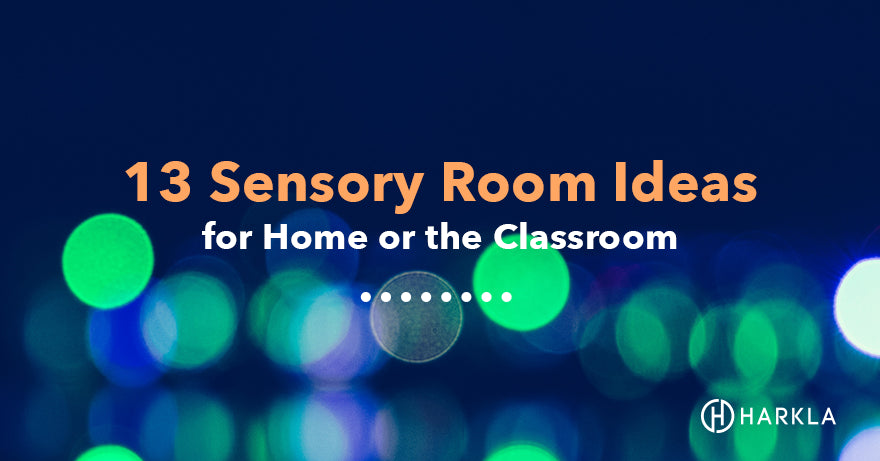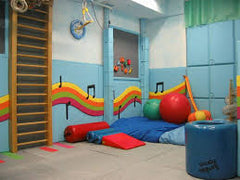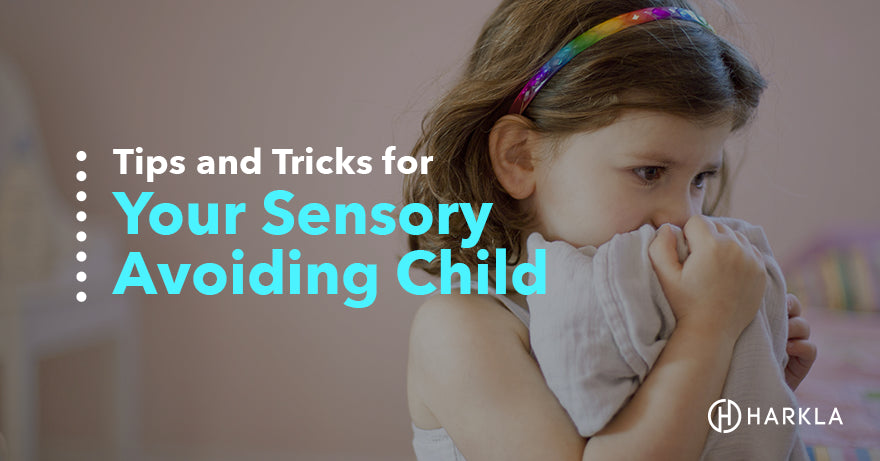Your Cart is Empty

Sensory rooms are becoming more popular in homes, clinics, and schools. The rooms are designed to assist someone in organizing, calming, relaxing, and seeking out sensory information.
The goal of a sensory room is to provide a safe place where someone who has Sensory Processing Disorder (SPD) can go when they need to either calm or stimulate their senses. They can be as varied as the people who use them.
Sensory rooms provide a great variety of activities to help engage the senses. For information about sensory integration and sensory integration therapy, read our post here.
Many hidden benefits exist when using a sensory room. People with sensory and other cognitive and physical disabilities often feel empowered when controlling the environment around them. A sensory room allows users to use whatever piece of equipment they need at the time.
For example, someone may have difficulty when overstimulated by noise. She can enter a sensory room and use the items she feels would best make her feel comfortable and more in control of her own body’s regulation. After spending time in the sensory room, many experience improved concentration, creativity, and expression, along with better gross motor skills and reduced stress or aggression.
On the other hand, children who are naturally more active often show sensory-seeking behavior. They may crave movement or pressure to stay focused, using weighted items or swings to feel where their body is in space.
If you want to dive a bit deeper on Sensory Rooms, there are 3 different styles of rooms to consider when building your own!
Tina Champagne, Occupational Therapist, discusses a ‘Sensory Room Umbrella.’ She names the sensory modulation room, sensory integration room, and Snoezelyn rooms.
A Sensory Modulation room is a space in which people go when experiencing a sensory meltdown, panic, or are in a crisis situation. Providing a safe place to de-escalate can mean the difference between someone accidentally injuring themselves when chemically driven panic reactions occur.
There may contain massage equipment, lighting that slowly changes colors, bubble tubes, calming scents, music, weighted blankets, bean bags, fidgets and other pieces of equipment designed for calming. Check out this inflatable sensory peapod for a calming spot where your child can relax.

Sensory Integration rooms are wonderful spaces designed for and used by therapists. You may have seen them in your therapist’s room. Swings, crash pads, scooters, gym and playground equipment, and many others are utilized for therapeutic purposes.
Occupational therapists can seek out additional training in order to properly use and work with children in the sensory integration room. Be sure to ask your OT if she is familiar with sensory processing when you schedule your first appointment.
Check out the SPD Foundation here for specific details about sensory treatment techniques. The OT makes specific client-centered functional goals and uses equipment to help prepare a client to engage and interact for optimal learning.
Therapists sometimes address underlying developmental patterns such as the palmar grasp reflex or symmetric tonic neck reflex. Strengthening or integrating these reflexes can support posture, handwriting, and overall sensory organization, essential foundations for learning and everyday activities.
Snoezelen rooms were first developed in Holland. The name is Dutch and the goal in this room is that the person using the room is in control. The specific needs of each person using the room are considered and there are no specific therapeutic goals. When using the room, the student decides what activities in which to participate.
Since we all have different sensory needs, the room should have a variety of activities and equipment within it. The goal is for the child (and/or adult) to seek out activities to help them regulate their body. When someone has poor processing of sensory information, they may become quite uncomfortable.
Another benefit of a sensory room is to de-escalate when in a crisis situation. Some may experience a great deal of anxiety when presented with sensory information which causes a panic reaction. Children on the spectrum, for example, may experience emotional overload that leads to autism tantrums or meltdowns. Having a familiar, comfortable space to decompress helps them recover faster and feel more secure.
Normal daily function and learning cannot occur when we feel out of control and disorganized. We call this anxiety sensory overload.
Others may require more of a sensory experience and seek out sensory information in the form of crashing, bumping, chewing, and more. Further, a great number of those with SPD can have mixed needs and seek input in some areas and avoid input in others.
If you're not sure where to start with building your sensory room, working with an Occupational Therapists to create a Sensory Diet specific to your child's sensory needs would be a great place to start!
There are many different types of sensory swings you could put into a sensory room for your child! Some are platforms or just fabric. You'll want to explore what type you think your child will like best.
Check out the Harkla pod swing and compression swing!
A swing is a great way to give your child vestibular input, which oftentimes can provide calm, as well as help your child learn where their body ends.
Whichever swing you decide to get, you'll want to make sure it's easy to install inside your home. Some can come with stands, while others are drilled into the ceiling.
For more information on the benefits of sensory swings, read our article about vestibular input!
Having some sort of lighting for your child that is different from day-to-day lights can provide not only relief but entertainment!
For more information on sensory lighting, we wrote an article all about it here! You'll find more examples of some sensory lighting in that article that can provide fun visual sensory input!
There are many different kinds to consider and it will depend on what your child prefers.
A balance beam is a wonderful basic piece of equipment for any sensory room. There are take-apart versions readily available on the market, but consider other options depending on space. Balance boards, stepping stones, and E-Z steppers are great alternatives that are space savers and portable. These activities naturally promote gross motor development
while giving kids the sensory input they crave.
Some sort of special seating for your child is a great idea for your sensory room. There are many different kinds of sensory seating to consider, and it depends on what your goal is with the seating.
If you want something that can be set on a regular chair, there are wiggle seats for that.
If you want something that provides compression, you could consider the Harkla Hug, which your child can sit in and get the feeling of a hug!
You can read our article here about sensory seating options to consider.
A low table and a shallow storage container can serve as a sensory bin anytime and let you rotate different textures too. A sand/water table is great for flexibility and ease of use/clean up. Rice, beans, kinetic sand, pasta, and shaving cream are fun tactile media to explore. Putty and Play-Doh are go-to’s to help develop the intrinsic muscles of the hand and carryover to fine motor skills.
Jumping delivers proprioceptive and vestibular input to people of all ages. Trampolines come in several different shapes and sizes, some versions have a handle for younger children, and others can accommodate several users at once. Models with folding legs allow for saving space.
Body socks are a fun, but goofy looking tool!
They offer great sensory input and can actually be used in specific ways to improve a child's sense of their body.
To learn more about Body Socks, check out our article that includes more about the benefits, as well as fun activities you can do with them.
For a list of other sensory toys to consider, check out our blog post, The Ultimate List of Sensory Toys.
A cushion filled with foam, balls, or even air makes a great landing space. Kids can drag them around, toss them, climb under, or flop onto them. Use one under a climbing structure or as a crash zone when jumping off furniture or a trampoline. Yogibo makes a nice version that can also be used as a piece of furniture.
With so many options to get vertical, it’s hard to know where to start. A custom climbing wall can be space-saving, some families add climbing options to a solid wall in their stairway. While free-standing climbing structures do take up a lot of space, there are temporary/removable options to pair with suspended equipment and doorway swing hookups. Nets, ladders, and ropes can be interchangeable to offer different experiences and levels of challenges.
A yoga ball, stability ball, or physio ball is a flexible tool for a sensory space. Use a small one as a seat that allows for some movement to help promote focus and attention. A larger one can be rolled over in prone to target upper body strength, sat on to challenge postural control, used for deep pressure input as a “steam roller” or bounced on for vestibular input. A Bosu (half) ball can also have similar benefits, and challenge balance while in standing.
A fold-up or collapsible tunnel can encourage crawling, be used as a part of an obstacle course, or be used as a visual enclosure when needed. Kids can crawl inside on their bellies to help focus on homework or pull in a blanket or a pillow to decompress after a long day at school. Setting up a quiet space or a sensory deprivation area is an important part of a sensory room, and at home for a child with sensory processing disorder.
Find a flat wall and take your pick of Plexiglas, mirror, paper, chalkboard, or whiteboard Working upright on a vertical surface helps to promote grasp development and encourages visual-motor skills. Chalkboard paint is now readily available at many home improvement stores if you don’t want to commit to a “board” or wall hanging. Play with magnets, wall clings, different adhesives and art mediums for tactile experience.
Having some sort of weighted product that can provide a feeling of being grounded is a great idea.
This grounded feeling of weight is called Deep Touch Pressure, and is calming due to the release of serotonin in the body.
Since you are creating a sensory room, you'd want to find a blanket or lap pad that can provide extra sensory input beyond just the weight.
Here at Harkla, we make our weighted blankets and lap pads with a dotted minky fabric, which offers an extremely soft surface to run your hands across.
If you aren't familiar with weighted blankets, we've written a post you can find here about the benefits of them.
Recent research also shows that overall well-being improves when sensory support is paired with good nutrition. Nutrients like zinc, glutathione, and healthy gut bacteria can play a role in regulating stress and mood. For families exploring additional options, here’s a helpful guide to supplements for autism.
.
If you're new to the sensory world, then learning a little bit more about sensory processing disorder could be helpful!
First off, we know there are eight senses: vision, smell, hearing, taste, touch, vestibular (movement), proprioception (position in space), and interoception (internal information from organs and receptors). Nutrition and metabolic factors can also affect how these systems work; for example, studies on the ketogenic diet and autism show potential benefits for improving calmness and focus.
While there are many signs of SPD, here are some examples of difficulty processing sensory information:
For a detailed guide to sensory processing disorder, check out this article!
Consider adding a sensory room to help meet therapeutic goals, assist in calming, and make life more comfortable. It’s important to remember that we explore and interpret our environment through our senses. The most important thing is to provide a safe setting.
When a person can better process sensory information, he can often pay more attention to the teacher, learn functional skills, and even improve verbal skills. The possibilities are endless!
Do you have any questions about Sensory Rooms? Or any ideas we should add to our list?
Let us know in the comments!
I really did enjoy this article. As an occupational therapist I try to be an evidence-based practitioner. Is there anyway to get research to support the views and ideas in this article?
Hello. I wanna ask you somthing.
I am gonna move home to USA from Korea.
I was get S.I therapy in Korean.
But most of S.l therapy in korea is personal room.
I wanna know that how many therapist(S.l) can have in a one room. May be that room will be 100 m².
3 therapists is okay for one S.l room?
My 3 years old son struggles to fall asleep since birth..sometimes wakes up in the middle of the night..i tried my best for his improvement but failed.
I have a brother who has all these sensory issues and it creates anxiety in him. He is also IDD but her is not a child, he is 44 years old. He knows he is a “man” because he sees other people who look like him (size and age) and is smart enough too know tunnels and toys are not what he “should” be playing with so he feels uneasy about them although he is very much a child. He loves Mr Rogers, Sesame Street etc but also adult shows like 90’day Fiance etc. He enjoys his independence and freedom to be able to choose what he wants to watch and “like” but is still very much a child of mind. It is a very hard balance. He is unable to independently without instruction: bath, feed, share or know his emotions, get very nervous in crowds, lighting or any change at all to his environment is a big NO. He has mood swings because he cannot put his emotions into words. And so on. Any ideas for the older child caught in the adult body with these exact issues you are addressing? I’d love to hear your thoughts. Balance, putting too much into mouth, favoring sweets, clothing. His “safe space that he controls has turned into our living room with control over the living room and us lol
I need help with my daughter’s bedroom
Hey Emma,
Thanks for reading our blog! The cost can vary quite a bit but a sensory room can be affordable if you look for sales on the products you want or if you do some DIY products.
All the best,
Nicole from Harkla
What is the cost of these things?
Great ideas! Have you ever designed a whole classroom for kids with high sensory needs?
Comments will be approved before showing up.


Doug Adams
February 16, 2023
Sensory Room- I am fortunate to have a classroom converted to Sensory room. Lighting muted by skins-trees and such over the sensory tent, clouds above the swing. For bang for your buck- small trampoline is worth its weight in gold.I think EVERY classroom in America should have at least one. Hanging swing that spins can help kids who normally have trouble regulating. Back in the days, how someone reacted to spinning was a spectrum “tell”. I do have a crash pad and use it for “trust falls” but you can usually find our therapy dog on it! Also, acoustic music played with sensory images projected on the wall- Search sensory images on YouTube. I am still just using the free ones, but they have an awesome selection!